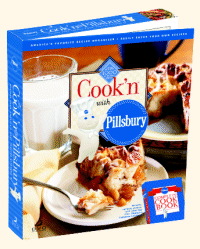
|
Never miss another recipe... Sign up for our free monthly newsletter today!
Subscribing will not result in more spam! I guarantee it! NEWSLETTER
• Current Issue• Newsletter Archive • Sign Up Now 
Cook'n with Betty Crocker 
Cook'n with Pillsbury 
Cook'n with a Taste of Home 
Cook'n in Italy 
Cook'n in Mexico |
 |
Nutritional Comparison |
|
Print this Recipe Comparing Fats and Oils Fat Source Saturated Monounsaturated Polyunsaturated Cholesterol (%) (%) (%) (mg/Tbls) Canola Oil 6 62 32 0 Safflower Oil 9 12 75 0 Sunflower Oil 10 20 66 0 Corn Oil 13 24 59 0 Olive Oil 14 74 8 0 Margarine, stick 14 39 24 0 Margarine, soft tub 14 32 31 0 Soybean Oil 15 43 38 0 Peanut Oil 17 46 32 0 Vegetable Shortening 25 45 26 0 Palm Oil 49 37 9 0 Butter 62 29 4 33 Coconut Oil 87 6 2 0 Smart Foods Choices Food Category Choose More Choose Less Breads, Cereals Rice, Pasta Baked Goods Fruits Vegetables Meat, Poultry Fish Beans, Peas Eggs Milk, Cream Cheese Yogurt Frozen Desserts Fats, Oils Spreads Chocolate Risk Factors for Coronary Heart Disease (CHD) High blood cholesterol High blood pressure Family history of coronary heart disease before the age of 55 Sedentary lifestyle Cigarette smoking Vascular disease Obesity Being male Diabetes What do the Numbers Mean? Cholesterol (mg/dl) Classification Total less than 200 Desirable Total 200 to 239 Borderline-High Risk Total above 239 High Risk LDL less than 130 Desirable LDL 130 to 159 Borderline-High Risk LDL above 159 High Risk HDL above 35 Desireable Fiber-Full Foods Foods containing 6 or more grams of fiber: 1 cup cooked kidney, black or baked beans 1 cup bran cereal 5 dried figs 1 cup raspberries 2 ounces uncooked whole wheat spaghetti Foods containing 4 to 5 grams of fiber: 1 pear 1 large apple 1 medium baked potato with skin 3 dried prunes 1 medium avocado 1 orange Foods containing 2 to 3 grams of fiber: 1 ounce peanuts 1/3 cup raisins 1/2 cup cooked brown rice 1 medium sweet potato 1/2 cup corn 2/3 cup flake or oat cereal Nutritional Facts Label Here’s what the label looks like with an explanation of its new features. Nutritional Facts Title: The new title “Nutritional Facts” signals the new label. Serving Size: Serving sizes and standardized based on amount people actually eat. Now similar food products have similar serving sizes making it easier to compare foods in the same category. New Label Information: Some label information may not be familiar to you. The nutrient list covers those nutrients most important to your health. You may have seen this information on some old labels, but now it is required by the government and must appear on all food labels. % Daily Value: The Present Daily Value shows how a food fits into a 2,000 calorie reference diet. These levels are based on dietary recommendations for most healthy people. Percent Daily Values help you judge whether a food contains “a lot” or “a little” of key nutrients important to health. Vitamins and Minerals: The Percent Daily Value replaces the Percent U.S. RDA for vitamins and minerals. The levels are the same. Only vitamin A, vitamin C, calcium, iron, and fortified nutrients are required on the new label: Additional vitamins and minerals can be listed voluntarily. Daily Values Footnote: Daily Values are the new label reference numbers. These numbers are set by the government and are based on current nutrition recommendations. Some labels list Daily Values for a diet of 2,000 and 2,500 calories per day. Your own nutrient needs may be less than or more than the Daily Values on the label. Calories Per Gram Footnote: Some labels tell the appropriate number of calories in a gram of fat, carbohydrate, and protein. (One gram is about the weight of a regular paperclip.) This information helps you calculate the percentage of calories from theses nutrients. Label Numbers: Numbers on the nutrition label may be rounded for labeling. Label Nutritional Claims Now, you can believe the claims on the food labels. Some food packages make claims such as “light,” “low fat,” and “cholesterol free.” Keep in mind that these claims are for packaged food products, not necessarily recipes, and can be used only if a food meets strict government definitions. Here are some of the meanings: Label Claim Definition (per serving) Low Calorie 40 calories or fewer Light (or Lite) 1/3 fewer calories or 50 percent less fat than the original product; if more than half the calories are from fat, fat content must be reduced by 50 percent or more Light in Sodium 50 percent less sodium Fat Free Less than 0.5 gram of fat Low Fat 3 grams or fewer of fat Cholesterol Free Fewer than 2 milligrams of cholesterol and 2 grams or fewer of saturated fat Low Cholesterol 20 milligrams or fewer of cholesterol and 2 grams or fewer of saturated fat Sodium Free Fewer than 5 milligrams of sodium Very Low Sodium 35 milligrams or fewer of sodium Low Sodium 140 milligrams or fewer of sodium High Fiber 5 grams or more of fiber From "Betty Crocker's Low-Fat, Low-Cholesterol Cooking Today." Text Copyright 2005 General Mills, Inc. Used with permission of the publisher, Wiley Publishing, Inc. All Rights Reserved. This recipe comes from the Cook'n collection. Try Cook'n for FREE! Here’s to your health Fat Facts Understanding Cholesterol Other Important Nutrients Putting It All Together Reading a Nutrition Label Go Slow For Success Test Your Health IQ The Skinny on Fat Cholesterol Trimming Tips Nutritional Comparison |
|
|
Affiliate Program | Privacy Policy | Other Resources | Contact Us
© 2008 DVO Enterprises, Inc. All rights reserved. Sales: 1-888-462-6656 |

